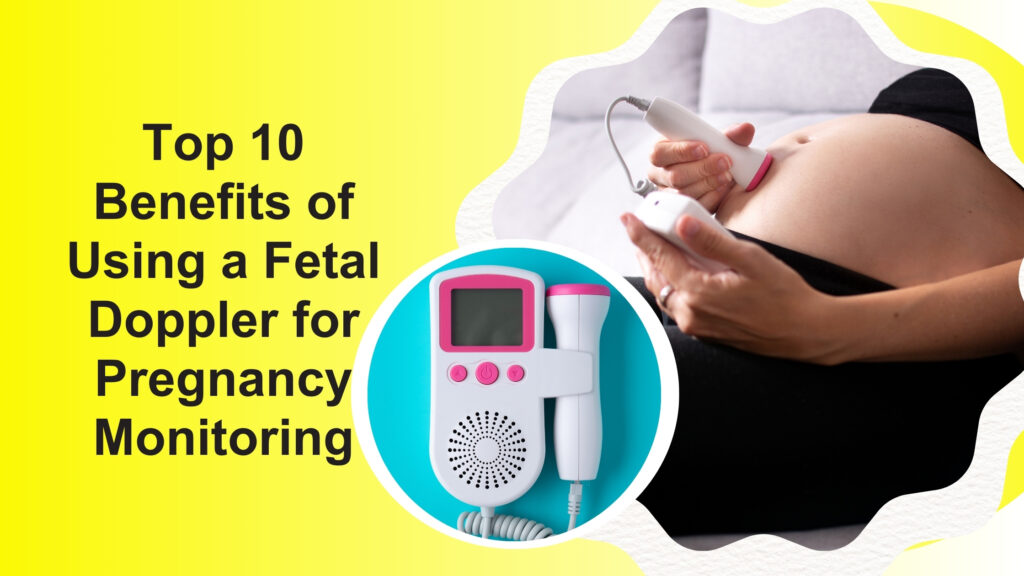Currently Empty: $0.00
Monitoring Fetal Heart Rate for Ensuring Baby’s Well-Being
 Bringing a new life into the world is a journey that is both wondrous and complex. Throughout pregnancy and labor, ensuring the well-being of the developing baby is of paramount importance. Fetal heart rate monitoring is a pivotal medical practice that allows healthcare providers to assess the baby’s heart rate and make informed decisions about their health and safety. In this article, we delve into the reasons behind fetal heart rate monitoring, its timing, types, and the significance of its results.
Bringing a new life into the world is a journey that is both wondrous and complex. Throughout pregnancy and labor, ensuring the well-being of the developing baby is of paramount importance. Fetal heart rate monitoring is a pivotal medical practice that allows healthcare providers to assess the baby’s heart rate and make informed decisions about their health and safety. In this article, we delve into the reasons behind fetal heart rate monitoring, its timing, types, and the significance of its results.
Contents
- Why is Fetal Heart Rate Monitoring Performed?
- When is Fetal Monitoring Done?
- What Are The Types of Fetal Heart Monitoring?
- When Do I Get to Know The Results of the Fetal Heart Rate Monitoring Test?
- Can Fetal Heart Rate Monitoring Help Determine The Gender of The Baby?
- Are At-Home Fetal Heart Rate Monitors Safe?
- Are At-Home Fetal Heart Rate Apps Safe?
- Conclusion
Why is Fetal Heart Rate Monitoring Performed?
Fetal heart rate monitoring is performed to monitor the baby’s heart rate and detect any signs of distress or complications. The baby’s heart rate serves as a crucial indicator of their well-being, as it reflects their oxygen supply and overall health. By closely tracking the heart rate, medical professionals can identify any deviations from the normal pattern, which might signify underlying issues such as fetal distress, umbilical cord compression, or insufficient oxygen levels.
When is Fetal Monitoring Done?
Fetal heart rate monitoring is conducted at various stages of pregnancy and labor..During routine prenatal visits, external monitoring is often employed. This involves placing a device known as a Doppler ultrasound device on the mother’s abdomen. It uses sound waves to detect and display the baby’s heart rate on a monitor.
As labor progresses, internal monitoring might be recommended. This method involves attaching an electrode directly onto the baby’s scalp, allowing for continuous and precise heart rate measurement. Internal monitoring is particularly useful during labor when more accurate data is needed to guide medical decisions.
What Are The Types of Fetal Heart Monitoring?
There are two primary types of fetal heart rate monitoring:
External Fetal Heart Rate Monitoring:
This method involves placing a device on the mother’s abdomen to monitor the baby’s heart rate. It is often used during prenatal check-ups and in the early stages of labor. The Doppler ultrasound device or fetal heart rate monitor emits sound waves that bounce off the baby’s heart, creating a heartbeat pattern on a monitor.
Internal Fetal Heart Rate Monitoring:
Internal monitoring is more precise and is often used during labor. A thin wire with an electrode is gently inserted through the cervix and attached to the baby’s scalp. This provides continuous and accurate heart rate data, allowing healthcare providers to make real-time decisions.
When Do I Get to Know The Results of the Fetal Heart Rate Monitoring Test?
The results of fetal heart rate monitoring are typically assessed by the healthcare provider in real time. During labor, the healthcare team keeps a close watch on the heart rate patterns and can intervene if there are any concerning deviations. The information gathered from monitoring aids in determining the appropriate course of action, such as adjusting labor interventions or considering a cesarean section if needed.
Can Fetal Heart Rate Monitoring Help Determine The Gender of The Baby?
Fetal heart rate monitoring is a medical procedure used to assess the well-being of a developing fetus during pregnancy. It involves measuring and tracking the baby’s heart rate over a certain period. While fetal heart rate can provide important information about the health of the fetus, it is not a reliable method for determining the gender of the baby.
There is a common misconception that the heart rate of a developing fetus can indicate its gender, with certain heart rate ranges supposedly corresponding to either a male or female baby. However, this is not supported by scientific evidence or medical consensus.
Fetal heart rate can vary throughout pregnancy due to factors such as the baby’s developmental stage, maternal activity, and maternal health. It is influenced by the autonomic nervous system, which responds to various physiological changes. Additionally, each fetus is unique, and heart rate patterns can differ significantly between individual pregnancies.
Gender determination is typically done through prenatal genetic testing (such as amniocentesis or chorionic villus sampling) or through ultrasound imaging. Ultrasound can sometimes provide an indication of gender, but even this is not always 100% accurate, especially during early stages of pregnancy. The fetal monitor cannot determine the gender of the baby.
Are At-Home Fetal Heart Rate Monitors Safe?
At-home fetal heart rate monitors, also known as Doppler devices, are handheld ultrasound devices that allow pregnant individuals to listen to their baby’s heartbeat. While these devices can provide a sense of reassurance and connection for some expecting parents, it’s important to consider their safety and use them with caution:
Professional Guidance: If you’re considering using an at-home fetal heart rate monitor, it’s recommended to consult with your healthcare provider first. They can provide guidance on the proper use of the device and whether it’s appropriate for your specific pregnancy situation.
Risk of Misinterpretation: At-home monitors may lead to misinterpretation of the fetal heart rate. Non-medical users might mistake their own heartbeat or other sounds for the baby’s heartbeat, causing unnecessary stress and confusion.
False Reassurance or Anxiety: Hearing a heartbeat does not necessarily indicate the baby’s overall health. It’s possible for the baby’s heart rate to be normal while other issues exist. On the other hand, any difficulties in locating the heartbeat might cause undue anxiety.
Overuse: Frequent and prolonged use of at-home monitors might lead to unnecessary exposure to ultrasound waves. While the potential risks are not well-defined, it’s generally advisable to limit ultrasound exposure to what is medically necessary.
Limitations of Sound-Only Monitoring: Listening to the heartbeat through a Doppler device provides only limited information about the baby’s well-being compared to medical-grade monitoring equipment used by healthcare professionals.
Medical Expertise: Healthcare professionals use more advanced equipment and have the training to accurately interpret fetal heart rate patterns and identify potential issues.
Possible Delays in Seeking Professional Help: Relying solely on an at-home monitor might lead to delayed detection of genuine problems that require prompt medical attention.
In summary, while at-home fetal heart rate monitors can provide an emotional connection and reassurance for some parents, they should be used cautiously and with the guidance of a healthcare provider. These devices are not a substitute for proper prenatal care, and any concerns about the baby’s health or well-being should be addressed by a qualified medical professional.
Are At-Home Fetal Heart Rate Apps Safe?
The safety and reliability of at-home fetal heart rate apps can vary significantly depending on the app’s quality, accuracy, and the user’s understanding of their limitations. It’s important to approach these apps with caution and consider the following points:
Accuracy: The accuracy of at-home fetal heart rate apps can be questionable. These apps often rely on smartphone sensors to detect the fetal heart rate, which may not be as precise as medical-grade equipment used in healthcare settings.
False Sense of Security: Relying solely on at-home apps for monitoring fetal heart rate can give parents a false sense of security. If there are any concerns about the baby’s health or well-being, it’s crucial to consult a healthcare professional.
Medical Oversight: These apps are not a replacement for regular prenatal care. It’s important for pregnant individuals to receive proper medical monitoring and assessments from qualified healthcare providers.
Lack of Regulation: The lack of regulation in the development and distribution of health-related apps can lead to a wide range of quality and accuracy among different apps.
User Understanding: Users may not fully understand how to interpret the data provided by the app or may misinterpret the results, leading to unnecessary anxiety or confusion.
Reliability: Connectivity issues, device variations, and user error can all impact the reliability of at-home fetal heart rate apps.
Conclusion
Fetal heart rate monitoring stands as a cornerstone in the care of expectant mothers and their babies. By monitoring the baby’s heart rate, healthcare providers gain invaluable insights into the baby’s well-being, allowing them to respond promptly to any potential complications.
Through external and internal monitoring methods, medical professionals can make informed decisions about the management of labor and ensure the safest possible delivery for both the mother and the baby. As a critical tool in modern obstetrics, fetal heart rate monitoring exemplifies the intersection of technology, medical expertise, and compassionate care on the journey to bringing new life into the world.






